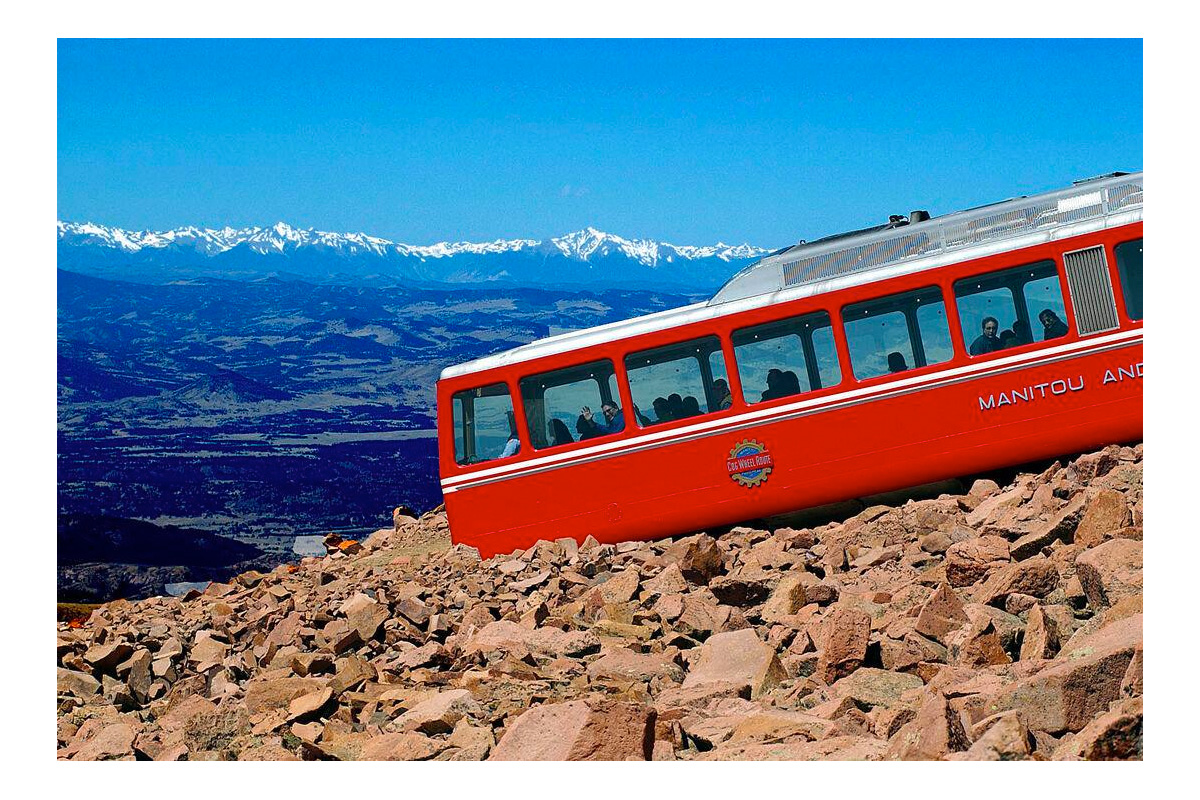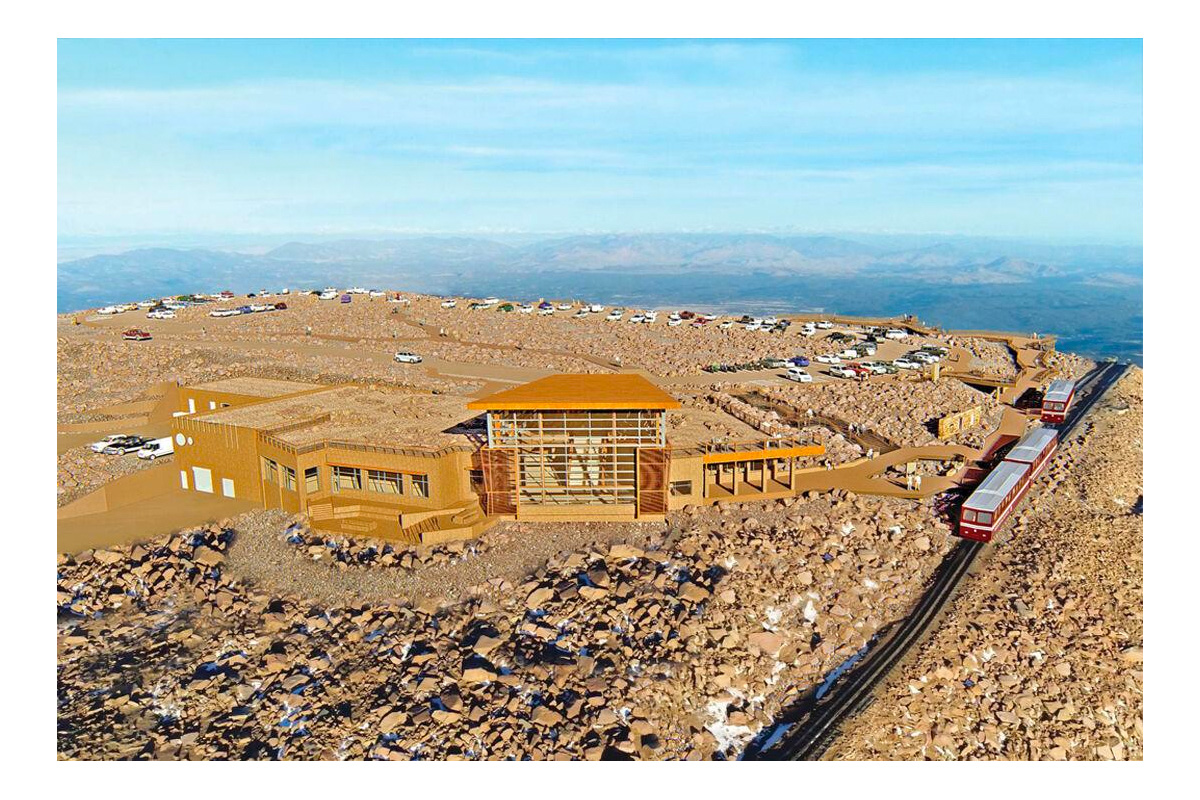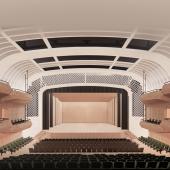Pikes Peak Cog Railway and the New Summit Visitors Center
Massive investments in the Pikes Peak Cog Railway and the new Summit Visitors Center reaffirm the mountain’s status as one of the world’s can’t-miss attractions. After nearly two years of construction, the Broadmoor Manitou and Pikes Peak Cog Railway plans to reopen May 1.
A Railway on Pikes Peak is No Small Feat
The nine-mile railway has taken guests to the top of Pikes Peak since 1891 and was in need of heavy maintenance, says Ted Johnston, assistant general manager at the Cog Railway. “The initial thought was we would do some heavy maintenance between October 2017 and May of 2018,” Johnston says. “We kind of put Band-Aids on it over the years. We were thinking we would just go in and fix those items finally, but as we started looking at those items, the cost of heavy maintenance started to outweigh the cost of replacing new.”
After six months of planning, construction began in March 2019 to replace the tracks, upgrade the depot, refurbish some trains in-house, and bring in four new trains. The $100 million project is funded by the Anschutz Corporation.
When the Cog Railway reopens, guests will find a combination of familiarity and new features. “It’s going to be the same experience that it was in terms of the trip up to the summit, but it’s going to be ushered into the 21st century in terms of new trains, new track, a completely renovated depot, upgraded gift shop,” Johnston says. “But it’s still going to be the same experience that is has been for the last 130 years of taking people to the summit of Pikes Peak.”
The trains will sit on new tracks, but the views and path up the mountain will be the same as before. Johnston says the railway had to stay within the original right of way. However, the ride will be more comfortable, he says. Four new trains will come from Stadler Rail in Switzerland, which purchased the company that built the original trains. The trains have upgraded seats, an upgraded PA system—and heat.
Construction on Pikes Peak has been no small feat. Crews had to navigate weather at the top of the mountain and COVID-19 challenges.
“One of the biggest challenges we faced weather-wise at altitude was actually not snow, because we planned everything to be working at the higher altitudes in the late spring and summer and early fall to try and avoid snow as best as possible,” Johnston says. “The biggest issue we faced up on the mountain was lightning because lightning is more prone at those altitudes than it is down here at the base of the mountain.” In addition to keeping an eye on the sky, construction crews and staff used lightning-detection equipment and weather apps on their cell phones.

Reconstruction of the railway involved teams from around the world, which caused a small hiccup, Johnston says. Most components for the railway came from essential businesses that were allowed to stay open even with COVID-19 restrictions in place. However, one factory in Switzerland closed for a week because they were not originally classified as essential, Johnston says.
“When you’re trying to manage a project of this scale, it takes some very precise timing of things and trying to make that all come together,” he says. “The logistics is the biggest key to this. We obviously got thrown this curveball called COVID-19 that nobody was expecting, and what we’ve been able to do to manage through that and continue construction has been amazing. The fact that we are still on schedule to reopen in May is, from a logistics standpoint, spectacular.”
When it comes to guest safety, Johnston says the Cog Railway is taking a 30-day approach. “COVID is an ever-changing bull’s-eye right now with restrictions,” Johnston says. “So, we’re looking at COVID through the lens of a 30-day outlook because anything beyond 30 days, trying to plan for at this point is just foolish.”
Capacity at the railway will be announced closer to its opening. In the meantime, guests will be encouraged to purchase tickets online—something not previously offered at the Cog. The Cog Railway will also celebrate 130 years on June 30. At time of publication, a celebration is still in the works.
“We’re thrilled that our ownership is investing the amount of money they are into this historic attraction Pikes Peak region in Manitou Springs. And we cannot wait to keep taking people to the summit of Pikes Peak for another 130 years,” Johnston says.
38,000 Square Feet of Welcome
Sitting at the summit of Pikes Peak will soon be a new visitor center welcoming the more than 750,000 people who visit the top of the mountain each year.
The old Summit House was built on top of Pikes Peak in the mid-1960s. “It definitely exceeded its useful life,” says Sandy Elliott, parks operations administrator at Pikes Peak. “It’s seen millions of people over the course of its years. It was a bit run down, built with old materials, and in need of some maintenance. It really was time to start looking at a new facility.”
Construction of the new Summit Visitor Center, which is more than double the size of the old Summit House, began in 2018. The Summit House closed to the public in early January, and the new facility is expected to open in late May.

Building the Summit Visitor Center is estimated to cost $60–$62 million, and it will feature interpretive exhibits, retail and dining components, and more. Funding comes from Pikes Peak, city revenue bonds, and an ongoing public campaign.
Similarly to the Cog Railway, constructing a 38,000-square-foot building on the summit of Pikes Peak came with its own set of challenges, Elliott says. Although city staff is accustomed to the environment at 14,000 feet, many construction crews were not. “This is probably the toughest project I’ve been involved with because of the elevation,” says Tim Redfern, construction manager/field operations with GE Johnson. “It’s known as one of the highest construction sites to be going on in the world currently.” The company used high-altitude research conducted by the Army Research Lab to make sure staff was prepared and able to work up there. Redfern, a Colorado Springs native, says about 10% of his workforce was not able to operate at such high altitudes.
Another challenge was delivering materials to the summit. Because of the vehicle size restrictions on the Pikes Peak highway, GE Johnson had to consider new ways to get the materials up the mountain. Elliott says, “They did a very good job of learning the road and scheduling material deliveries before we’re open to the public since their vehicles are oversized, and they’d be taking up both lanes.”
Lightning was also a challenge, says Brian Calhoun, a principal with RTA Architects who worked on the new building. The new Summit Visitor Center is a precast concrete structure made in Colorado Springs. Once the materials were trucked to the summit, a crane was used to erect it. However, most construction was done in the summer, which meant afternoon storms were common. “Every time lightning is within one mile, they shut the work down,” Calhoun says.
The construction challenges will be worthwhile when the new visitor center opens. The center will showcase interpretive exhibits featuring the history of the peak and the people who first visited the summit in addition to details about the landscape itself. Elliott says a large digital touchscreen wall will provide guests with a hands-on experience. The wall includes photos of the past and present and a map on which visitors can indicate their hometown.
The retail and dining areas will offer a new gift shop and café. The new facility will also have a doughnut machine. In gathering public feedback back in those early design phases, one of the top comments was “don’t get rid of the doughnuts,” Elliott says. The old doughnut machine was disassembled and removed from the mountain. The new, larger machine—which will make doughnuts with the same top-secret recipe as before—will operate in a more energy-efficient way, Elliott says.
The facility also blends into the natural landscape of the mountain. Elliott says the city received a lot of feedback about not outdoing the mountain because people come to the summit for the views. “We wanted a building and a design that, when you got up to the summit, whether you rode the train, you hiked, or you drove your vehicle up, you were experiencing the mountaintop, not looking at a big building,” she says. “The entire design is intended to extend that feeling of being on the natural landscape.”
Architects on the project include RTA Architects and GWWO, who were challenged with nestling the building into the mountain. “We wanted it to be a building that really capitalized on views and the visitor experience, but tucked into the mountainside,” Calhoun says. “Now, it makes the experience much more about being on a 14er and less about the building itself.” The old Summit House was a retail store and restaurant; the new center has the same amenities but feels like less of a commercial experience, he says.

To further blend the new building with the mountain, boulders are placed in the parking lot as wheel barriers, and an elevated walkway is the color of nearby rocks as compared with traditional black asphalt or gray concrete. Rocks are also extended from the walkway to the roof of the Summit Visitor Center, which serves as an overlook where guests can walk, Elliott says. The center itself is also made of same color clad and stone as the Pikes Peak granite, Calhoun says.
The new facility is also ADA accessible. “We’re really proud that we’re able to do this, especially on the top of the mountain, on top of a 14er,” Elliott says.
The opening of the Summit Visitor Center will also coincide with the launch of a new Pikes Peak Summit Experience app, Elliott says. “another way for people to engage and learn more about Pikes Peak.”
By the time you read this, you will likely be able to experience it for yourself. “We’re down to the hardest part of the project, trying to work through this winter, and we’ve had great success,” says Redfern. “The Pikes Peak Highway crew have been keeping the road open, getting 20 miles of road plowed before our crews get there at 6 a.m. It has been a great collaboration between us and Pikes Peak–America’s Mountain.”





